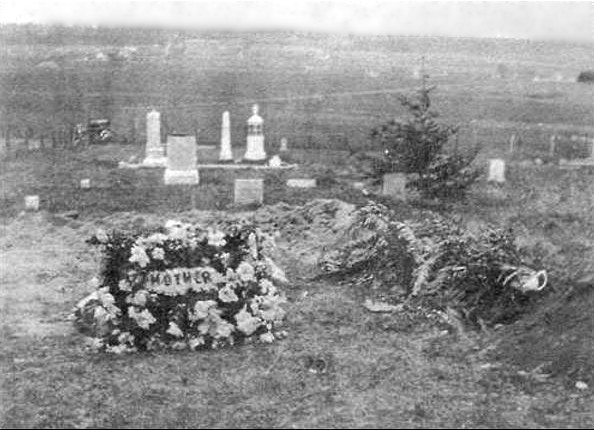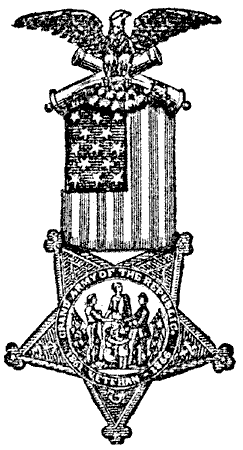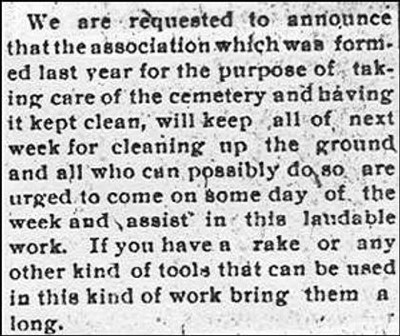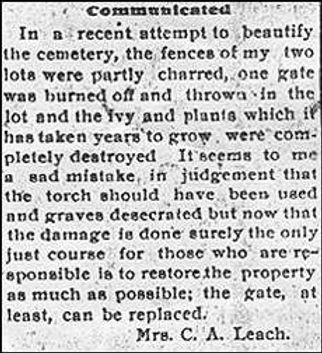The History of Sunnyside Cemetery
1900 - 1922


Photo courtesy of Lillian Huffstettler
The twentieth century brought steady change to the central Whidbey community—and its cemetery above Ebey's Prairie. On August 31, 1902, Dr. John Kellogg died in Seattle at age eighty-one; two days later a steamer brought his remains back to Whidbey. He had first come to the island almost a half-century before and in recognition of his important role in the region's settlement, Coupeville's flags were lowered to half-staff. A large funeral cortege accompanied him to the cemetery he had begun in 1875 and witnessed his burial in the original Ebey Grave Yard, in the lot where he and his wife, Caroline, buried their eldest child, Florence, in 1870.
As an increasing number of the islands' pioneer families died, the change registered perceptibly at Sunnyside Cemetery [by this time the name commonly given to the space encompassed by the Ebey Grave Yard, Valley View, and Sunnyside cemeteries.] The graveyard did not have a custodian responsible for maintenance of the grounds and consequently the care of individual lots was the owner's responsibility.
With the death of those owners and their descendants the appearance of the cemetery became increasingly disheveled, which decreased proportionately the public's interest in "venerating the dead." Dr. Kellogg's son, Albert, had called attention to the problem in an 1893 letter to the Island County Times: "The way people leave the gates open and teams are driven across vacant lots and unprotected graves, I consider a public outrage. ...wagons have passed over the foot of my uncle's grave ... bruising and defacing the marble marker, also crossing the graves of John Engle's little children and others." One week later, Joseph Herbert echoed Kellogg's complaints in his own letter to the Times where he characterized the cemetery as "a wilderness of dead grass, hard to discriminate from laid out lots." He called for the cemetery's incorporation and a board of trustees to ensure the graveyard was well-run and maintained. But neither letter resulted in any changes.

GAR posts were named for military
personnel killed in the line of duty.
Coupeville's "Daniel
Chaplain Post 92" honored
a colonel killed in the Civil War
at the 1864 Battle of
Chapins Farm, Virginia.
Sunnyside Cemetery seemed to garner the community's attention but once a year, on the annual observance called Decoration Day. The event began in 1866, sponsored by the Grand Army of the Republic [GAR], a fraternal organization for Union veterans of the Civil War. The GAR had set aside May 30th as the day to "remember the sacrifices of fallen comrades", and by 1900 communities across America marked the event in their local cemeteries. In 1895, GAR Post 92 formed in Coupeville and took over sponsorship of the yearly observance, which soon became known as Memorial Day. Each May, the community gathered in Coupeville to make their way on foot and in wagons across Ebey's Prairie to Sunnyside. There they observed a "eulogy for the dead, patriotic music, and a salute fired", followed by the ritualistic "strewing of flowers" upon the graves.
DECORATION DAY
Memorial Services and Picnic at Sunny Side Cemetery
The people of Island County are invited to attend memorial services at Sunny Side Cemetery on Saturday, May 30, 1891. Program as follows:
9:30 AM:
Gentleman and boys will meet with rakes, scythes, sickles and hoes to improve and repair the grounds and care for neglected graves.
12:00 PM
The ladies will prepare a lunch for all
1:00 PM
Services as follows:
Song by school children
Prayer/Address Rev. George Lindsey
Song: school children
Reading, song: school children
Address: Rev. WH Wilson
Song: school children
Benediction
Decorating of graves by the children of the school and Academy after which the young people will be free to amuse themselves as they see fit.
Island County Times
May 1891
In 1912, the Coupeville branch of the Washington State Federation of Women's Clubs organized, calling themselves Ladies of the Round Table [LORT], and for their first civic project, they addressed the local cemetery's woebegone appearance. They began by organizing the Sunnyside Cemetery Association, whose initial clean-up of the graveyard was anything but auspicious. For in their eagerness to clear Sunnyside of unsightly weeds and grass they resorted to fire and burned more than just the vegetation: it is unknown how many wooden "headboards" were destroyed in that effort [the cemetery monument of choice at that time for those who could not afford a stone marker.] Efforts like these—combined with inadequate maintenance, and the failure to keep records of who was buried where—helped shape the current landscape of the cemetery. A walk through the older portions of Sunnyside today reveals seemingly empty spaces that contain no gravesites, when, in reality, many of those grave markers have long since disappeared.
In 1918 the minutes of the Masonic Lodge reported that their brethren traveled to a Sunnyside burial service in automobiles for the first time. That same year another milestone occurred when Island County undertook its first expansion of the county graveyard. Fifty years after purchasing the Ebey Grave Yard from Mary Bozarth, county commissioners paid Win Cook eleven hundred dollars for the four-plus acres of land just north of the cemetery. The Island County First Addition to Valley View added two hundred thirteen new lots to the cemetery overlooking Ebey’s Prairie, and marked Win Cook’s withdrawal from the cemetery business. In failing health, Cook died in 1927 at age seventy-three and was buried in the Cook family lot in the Ebey Grave Yard. There, in 1881, his parents interred their twenty-one-year-old son, Howard, following his death from tuberculosis.

4-25-1913

6-27-1913

